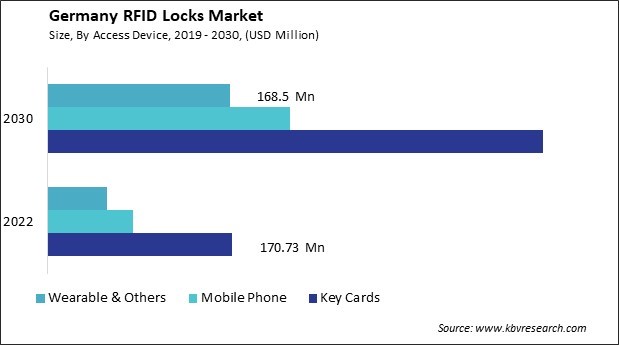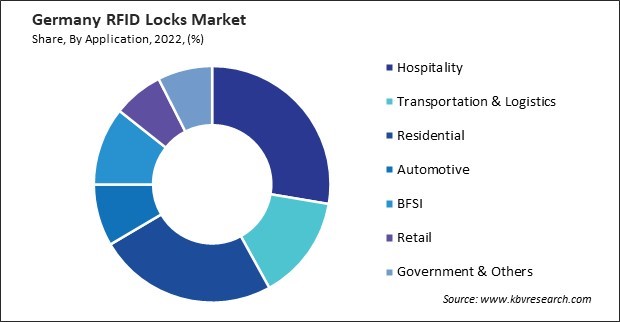Germany RFID Locks Market Size, Share & Trends Analysis Report By Access Device, By Application (Hospitality, Transportation & Logistics, Residential, Automotive, BFSI, Retail, and Government & Others), Outlook and Forecast, 2023 - 2030
Published Date : 26-Mar-2024 |
Pages: 59 |
Formats: PDF |
COVID-19 Impact on the Germany RFID Locks Market
The Germany RFID Locks Market size is expected to reach $851.39 million by 2030, rising at a market growth of 13.8% CAGR during the forecast period. In the year 2022, the market attained a volume of 2,069.80 thousand units, experiencing a growth of 13.3% (2019-2022).
The adoption of RFID locks in the security and access control sector has been steadily growing in Germany. RFID locks offer enhanced security features and convenient access control, making them popular in various residential, commercial, and industrial applications. One of the key drivers for adopting RFID locks in Germany is the growing awareness of the vulnerabilities associated with traditional lock systems. RFID locks offer enhanced security features, such as encryption and authentication, making it more challenging for unauthorized individuals to gain access. This has made them particularly appealing to businesses and organizations looking to upgrade their security infrastructure.

As a technologically advanced country, Germany is at the forefront of adopting innovative security solutions. RFID locks represent a leap forward compared to traditional lock and key systems. The continuous evolution of RFID technology, including improvements in encryption and authentication protocols, contributes to the industry's growth.
Market Trends
Smart buildings concept driving demand for RFID locks in the residential sector
The concept of smart buildings has become a driving force behind the increasing demand for RFID locks in the residential sector of the RFID locks market in Germany. As technology advances, homeowners increasingly embrace smart home solutions to enhance security, convenience, and overall living experience. RFID locks align perfectly with the smart buildings concept with their contactless and secure access control features.
One of the key factors fueling the adoption of RFID locks in residential settings is the emphasis on enhanced security. Traditional lock and key systems are gradually being replaced by RFID locks, which offer higher security through encrypted authentication processes. The ability to control and monitor access remotely via smartphones or other connected devices contributes to homeowners' sense of safety and peace of mind. Convenience is another significant factor driving the popularity of RFID locks in the German residential sector. With RFID technology, residents enter their homes effortlessly without needing physical keys. This is particularly advantageous when individuals have full hands or need to access their homes quickly. RFID locks' seamless and contactless nature aligns with the modern lifestyle, enhancing the overall convenience of daily activities.
Moreover, integrating RFID locks within the broader ecosystem of smart home automation systems contributes to their rising demand. Homeowners in Germany integrate RFID locks with other smart devices, such as security cameras, lighting systems, and thermostats, to create a cohesive and interconnected living environment. This integration not only improves the home's overall functionality but also offers a more personalized and tailored experience for residents.
Since 2019, the German Federal Ministry of Transport, Building, and Urban Affairs has actively advocated for German cities and municipalities in the development and execution of "digital strategies for livable cities" through the funding initiative "Smart Cities made in Germany." In the inaugural year, 13 cities or inter-municipal projects received funding, followed by 32 in 2020 and 28 more in 2021. This initiative greatly emphasizes leveraging digital technologies to enhance urban living.
In tandem with these efforts, the smart buildings concept has emerged as a significant driver of demand for RFID locks in Germany's residential sector. Integrating advanced technologies in building infrastructure aligns with the broader Smart Cities initiative, promoting efficiency, security, and sustainable urban living. The increased focus on smart buildings indicates a broader trend toward adopting innovative solutions to create more connected, intelligent living spaces in Germany. Hence, the increasing demand for RFID locks in Germany's residential sector is propelled by the smart buildings trend, emphasizing enhanced security and convenience.
High usage of RFID locks in the healthcare industry
In the healthcare sector in Germany, the adoption of RFID locks has witnessed a substantial surge, marking a significant trend in the broader RFID locks market. Integrating RFID technology into locking systems has proven to be a transformative solution, addressing key security and operational challenges within healthcare facilities. RFID locks offer a sophisticated and efficient means of access control, enhancing the overall security infrastructure in hospitals, clinics, and other healthcare institutions.
One of the primary reasons for the high usage of RFID locks in the healthcare sector is the need for stringent access control to safeguard sensitive patient information, medical equipment, and restricted areas within the facilities in Germany. RFID technology enables seamless and secure access, allowing authorized personnel to enter specific zones while maintaining a robust barrier against unauthorized entry. Moreover, RFID locks contribute to streamlined workflows in healthcare settings. By incorporating RFID technology into locks, healthcare professionals swiftly access necessary supplies and equipment, reducing the time spent searching for key assets. This efficiency is especially crucial in emergency situations, where quick access to medical resources substantially changes patient outcomes.
The implementation of RFID locks also enhances inventory management within healthcare facilities. Staff monitors usage, tracks inventory levels, and automates replenishment processes by utilizing RFID tags on medical equipment and supplies. This reduces the risk of shortages, minimizes wastage, and ensures that critical medical items are readily available when needed. Therefore, the rising adoption of RFID locks in the German healthcare sector underscores its pivotal role in fortifying access control, optimizing workflows, and bolstering overall security.

Competition Analysis
The RFID locks market in Germany has experienced substantial growth as the country continues to prioritize advanced security solutions and smart technologies. Several companies have emerged as key players in the German RFID locks market, contributing to developing and adopting secure access control systems. One of the leading companies in the German RFID locks market is SIMONSVOSS Technologies GmbH, a pioneer in digital locking and access control solutions. The company specializes in wireless and battery-powered RFID locks, offering high-security options for various industries. The company's RFID locks are known for their flexibility, allowing easy integration into existing security systems.
Another significant participant is ABUS Security-Center GmbH & Co. KG, a German company recognized for its comprehensive security solutions. ABUS provides RFID-enabled locks that cater to both commercial and residential applications. The company's RFID locks emphasize user-friendly access control while maintaining robust security measures, making them popular in Germany.
SimonsVoss Technologies GmbH, a German-based provider of digital locking and access control solutions, has established itself as a key player in the German RFID locks market. The company specializes in wireless and battery-powered RFID locks, offering high-security options for various industries. SimonsVoss's RFID locks are renowned for their flexibility, allowing seamless integration into existing security systems.
DOM Sicherheitstechnik GmbH & Co. KG, a German security technology company, is also notable in the RFID locks market. DOM provides RFID-enabled locks that are widely used in commercial and residential settings. The company's RFID locks prioritize advanced security features, contributing to their popularity in Germany. These companies play a pivotal role in driving innovation, ensuring security, and meeting the evolving needs of businesses and consumers in Germany by providing advanced and reliable RFID-enabled access control solutions.
List of Key Companies Profiled
- Allegion PLC
- Honeywell International, Inc.
- Siemens AG
- Assa Abloy AB
- Dormakaba Holding AG
- MIWA Lock Company, Ltd.
- Dolphin RFID Pvt. Ltd.
- Salto Systems, S.L.
Germany RFID Locks Market Report Segmentation
By Access Device
- Key Cards
- Mobile Phone
- Wearable & Others
By Application
- Hospitality
- Transportation & Logistics
- Residential
- Automotive
- BFSI
- Retail
- Government & Others
1.1 Market Definition
1.2 Objectives
1.3 Market Scope
1.4 Segmentation
1.4.1 Germany RFID Locks Market, by Access Device
1.4.2 Germany RFID Locks Market, by Application
1.5 Methodology for the research
Chapter 2. Market Overview
2.1 Introduction
2.1.1 Overview
2.1.1.1 Market Composition and Scenario
2.2 Key Factors Impacting the Market
2.2.1 Market Drivers
2.2.2 Market Restraints
2.3 Porter’s Five Forces Analysis
Chapter 3. Strategies Deployed in RFID Locks Market
Chapter 4. Germany RFID Locks Market
4.1 Germany RFID Locks Market by Access Device
4.2 Germany RFID Locks Market by Application
Chapter 5. Company Profiles – Global Leaders
5.1 Allegion PLC
5.1.1 Company Overview
5.1.2 Financial Analysis
5.1.3 Segmental Analysis
5.1.4 Research & Development Expenses
5.1.5 SWOT Analysis
5.2 Honeywell International, Inc.
5.2.1 Company Overview
5.2.2 Financial Analysis
5.2.3 Segmental and Regional Analysis
5.2.4 Research & Development Expenses
5.2.5 Recent strategies and developments:
5.2.5.1 Partnerships, Collaborations, and Agreements:
5.2.6 SWOT Analysis
5.3 Siemens AG
5.3.1 Company Overview
5.3.2 Financial Analysis
5.3.3 Segmental and Regional Analysis
5.3.4 Research & Development Expense
5.3.5 SWOT Analysis
5.4 Assa Abloy AB
5.4.1 Company Overview
5.4.2 Financial Analysis
5.4.3 Segmental and Regional Analysis
5.4.4 Research & Development Expense
5.4.5 Recent strategies and developments:
5.4.5.1 Product Launches and Product Expansions:
5.4.5.2 Acquisition and Mergers:
5.4.6 SWOT Analysis
5.5 Dormakaba Holding AG
5.5.1 Company Overview
5.5.2 Financial Analysis
5.5.3 Regional Analysis
5.5.4 Research & Development Expenses
5.5.5 SWOT Analysis
5.6 MIWA Lock Company, Ltd.
5.6.1 Company Overview
5.7 Dolphin RFID Pvt. Ltd.
5.7.1 Company Overview
5.8 Salto Systems, S.L.
5.8.1 Company Overview
5.8.2 Recent strategies and developments:
5.8.2.1 Product Launches and Product Expansions:
TABLE 2 Germany RFID Locks Market, 2023 - 2030, USD Million
TABLE 3 Germany RFID Locks Market, 2019 - 2022, Thousand Units
TABLE 4 Germany RFID Locks Market, 2023 - 2030, Thousand Units
TABLE 5 Germany RFID Locks Market by Access Device, 2019 - 2022, USD Million
TABLE 6 Germany RFID Locks Market by Access Device, 2023 - 2030, USD Million
TABLE 7 Germany RFID Locks Market by Access Device, 2019 - 2022, Thousand Units
TABLE 8 Germany RFID Locks Market by Access Device, 2023 - 2030, Thousand Units
TABLE 9 Germany RFID Locks Market by Application, 2019 - 2022, USD Million
TABLE 10 Germany RFID Locks Market by Application, 2023 - 2030, USD Million
TABLE 11 Germany RFID Locks Market by Application, 2019 - 2022, Thousand Units
TABLE 12 Germany RFID Locks Market by Application, 2023 - 2030, Thousand Units
TABLE 13 Key Information – Allegion PLC
TABLE 14 Key Information – Honeywell International, Inc.
TABLE 15 Key Information – Siemens AG
TABLE 16 Key Information – Assa Abloy AB
TABLE 17 Key Information – Dormakaba Holding AG
TABLE 18 Key Information – MIWA Lock Company, ltd.
TABLE 19 Key Information – Dolphin RFID Pvt. Ltd.
TABLE 20 Key Information – Salto Systems, S.L.
List of Figures
FIG 1 Methodology for the research
FIG 2 Germany RFID Locks Market, 2019 - 2030, USD Million
FIG 3 Key Factors Impacting RFID Locks Market
FIG 4 Porter’s Five Forces Analysis – RFID Locks market
FIG 5 Germany RFID Locks Market Share by Access Device, 2022
FIG 6 Germany RFID Locks Market Share by Access Device, 2022
FIG 7 Germany RFID Locks Market by Access Device, 2019 - 2030, USD Million
FIG 8 Germany RFID Locks Market Share by Application, 2022
FIG 9 Germany RFID Locks Market Share by Application, 2030
FIG 10 Germany RFID Locks Market by Application, 2019 - 2030, USD Million
FIG 11 SWOT Analysis: Allegion PLC
FIG 12 SWOT Analysis: Honeywell international, inc.
FIG 13 SWOT Analysis: Siemens AG
FIG 14 Recent strategies and developments: Assa Abloy AB
FIG 15 SWOT Analysis: Assa Abloy AB
FIG 16 Swot Analysis: Dormakaba Holding AG